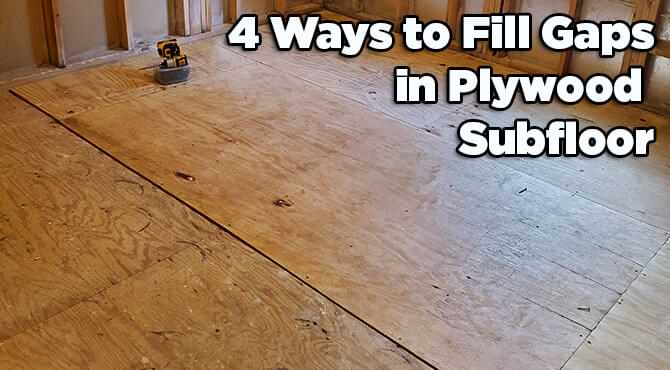How to Fill Gaps in Plywood Subfloor [4 Effective Ways]
To fill gaps in a plywood subfloor, you need to clean the gaps thoroughly, use a high-quality wood filler or caulk, and ensure the filler is level with the subfloor. Once dry, sand it down for a smooth finish. Properly filling these gaps prevents squeaking and ensures a stable base for flooring.

Filling gaps in a plywood subfloor is a crucial step in preparing your floor for a new finish. Whether you’re laying down tiles, hardwood, or carpet, having a smooth and even subfloor ensures the longevity and stability of your flooring.
Gaps in the subfloor can lead to squeaks, uneven surfaces, and even structural issues over time. This detailed guide will walk you through the process of filling gaps in your plywood subfloor, ensuring a flawless finish.
Table of Contents:=>
- 4 Ways to Fill Gaps in Plywood Subfloor:
- Filling Gaps in Plywood Subfloor – Step-by-Step Guide:
- 1. Assess the Subfloor
- 2. Gather Necessary Tools and Materials
- 3. Clean the Gaps
- 4. Apply the Chosen Filler
- 5. Sand the Filled Areas
- 6. Inspect the Surface
- 7. Prepare for Flooring Installation
- Frequently Asked Questions:
- Conclusion
4 Ways to Fill Gaps in Plywood Subfloor:
a) Wood Filler
Wood filler is one of the most common methods for filling gaps in a plywood subfloor. It is easy to apply, sand, and paint over.
- Clean the Gaps: Use a vacuum or compressed air to remove dust and debris from the gaps.
- Apply Wood Filler: Using a putty knife, apply the wood filler into the gaps, ensuring it fills the space completely.
- Smooth the Surface: Scrape off the excess filler to create a smooth surface.
- Let It Dry: Allow the wood filler to dry as per the manufacturer’s instructions.
- Sand the Area: Once dry, sand the filled area to ensure it is level with the subfloor.
b) Caulk
Caulk is flexible and works well for filling gaps that may expand and contract with changes in temperature and humidity.
- Clean the Gaps: Ensure the gaps are free of debris.
- Apply Caulk: Use a caulking gun to apply the caulk into the gaps.
- Smooth the Caulk: Use a putty knife or your finger to smooth the caulk, ensuring it fills the gaps completely.
- Let It Cure: Allow the caulk to cure as per the manufacturer’s recommendations.
c) Wood Strips
For larger gaps, wood strips can be an effective solution.
- Measure the Gaps: Measure the width and depth of the gaps.
- Cut Wood Strips: Cut strips of wood to fit the measured gaps.
- Glue the Strips: Apply wood glue to the edges of the strips and insert them into the gaps.
- Secure the Strips: Use a hammer or rubber mallet to tap the strips into place.
- Sand the Area: Once the glue is dry, sand the area to ensure it is level with the subfloor.
d) Epoxy Resin
Epoxy resin is a durable and long-lasting solution for filling gaps.
- Clean the Gaps: Remove any debris from the gaps.
- Mix the Epoxy: Follow the manufacturer’s instructions to mix the epoxy resin.
- Fill the Gaps: Pour or apply the epoxy into the gaps.
- Smooth the Surface: Use a putty knife to smooth the epoxy.
- Let It Cure: Allow the epoxy to cure completely.
- Sand the Area: Sand the cured epoxy to ensure a smooth, level surface.
Filling Gaps in Plywood Subfloor – Step-by-Step Guide:
1. Assess the Subfloor
Before you begin, thoroughly inspect your plywood subfloor to identify all gaps and determine their sizes. This will help you choose the best method for filling them.
2. Gather Necessary Tools and Materials
Depending on the chosen method, you may need:
- Wood filler or caulk
- Wood strips
- Epoxy resin
- Putty knife
- Sandpaper (various grits)
- Vacuum or compressed air
- Caulking gun
- Wood glue
- Hammer or rubber mallet
3. Clean the Gaps
Ensure all gaps are clean and free from dust, dirt, and debris. Use a vacuum or compressed air to clean the gaps thoroughly. This step is crucial to ensure proper adhesion of the filler material.
4. Apply the Chosen Filler
For Wood Filler:
- Use a putty knife to press the wood filler into the gaps.
- Smooth the filler so it is level with the subfloor.
- Allow it to dry completely before sanding.
For Caulk:
- Use a caulking gun to apply caulk into the gaps.
- Smooth the caulk with a putty knife or your finger.
- Let the caulk cure completely.
For Wood Strips:
- Cut wood strips to fit the gaps.
- Apply wood glue to the edges of the strips.
- Insert the strips into the gaps and tap them into place.
- Allow the glue to dry before sanding.
For Epoxy Resin:
- Mix the epoxy resin according to the manufacturer’s instructions.
- Pour or apply the epoxy into the gaps.
- Smooth the epoxy with a putty knife.
- Let the epoxy cure completely before sanding.
5. Sand the Filled Areas
Once the filler has dried or cured, use sandpaper to sand the filled areas. Start with a coarser grit and gradually move to a finer grit to achieve a smooth finish.
6. Inspect the Surface
After sanding, inspect the surface to ensure all gaps are properly filled and the subfloor is level. Make any necessary adjustments by adding more filler and sanding again if needed.
7. Prepare for Flooring Installation
With all gaps filled and the subfloor smooth and level, you can now proceed with your flooring installation. Whether you’re installing tiles, hardwood, or carpet, a properly prepared subfloor is essential for a successful project.
Frequently Asked Questions:
What is the best filler for plywood subfloor gaps?
The best filler depends on the size of the gaps and the specific requirements of your project. Wood filler and caulk are great for small to medium gaps, while wood strips and epoxy resin are better for larger gaps.
Can I use caulk to fill large gaps in plywood subfloor?
Caulk is best suited for small to medium gaps. For larger gaps, using wood strips or epoxy resin is recommended for a more durable solution.
How long does wood filler take to dry?
Drying time for wood filler varies by product. It typically takes between 30 minutes to a few hours to dry completely. Always refer to the manufacturer’s instructions for specific drying times.
Can I sand caulk?
While caulk can be smoothed during application, it is not typically sanded after curing. If you need a smooth, sandable finish, consider using wood filler or epoxy resin instead.
Is it necessary to fill all gaps in a plywood subfloor?
Filling gaps in a plywood subfloor is important to prevent squeaking, ensure a level surface, and provide stability for the finished flooring. All significant gaps should be filled for the best results.
Conclusion
Filling gaps in a plywood subfloor is an essential step in ensuring a stable and smooth foundation for your flooring. Whether you choose wood filler, caulk, wood strips, or epoxy resin, following the proper steps and using the right materials will result in a professional-quality finish. This detailed guide provides all the information you need to tackle this project with confidence, ensuring your flooring installation goes smoothly and lasts for years to come.
Last Updated on October 1, 2024 by Rogers Weber
[As an Amazon Associate I earn from qualifying purchases.]


